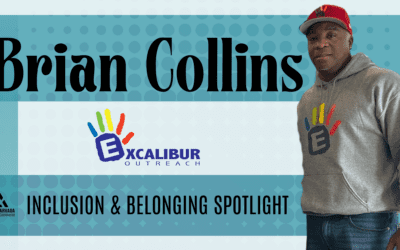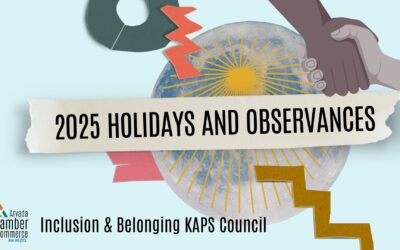This resource is hosted an updated by the Arvada Chamber’s Inclusion & Belonging KAPS Council. KAPS stands for Kick-Ass Problem Solvers and the business and community leaders on this council will work diligently to advance the Chamber’s inclusion commitment.
Belonging is at the heart of the Arvada Chamber’s core values and work to serve the Arvada business community. By creating an inclusive environment, the Chamber’s vision in this work is to empower new perspectives, solutions, and opportunities for our local economy and serve as a champion for advancing all businesses and employees in Arvada.
What is Inclusion & Belonging?
Inclusion & Belonging (I&B) is used to describe programs and policies that encourage the representation and participation of diverse groups of people. This includes people of different genders, races and ethnicities, abilities and disabilities, religions, cultures, ages, and sexual orientations, as well as those with diverse backgrounds, experiences, skills and expertise. A recent study showed that organizations with inclusive cultures are six times more likely to be innovative and agile than those with non-inclusive cultures.
Why is the Arvada Chamber focused on I&B work?
Belonging is at the heart of the Arvada Chamber’s core values and its work to serve the Arvada business community. By creating an inclusive environment, the Chamber’s vision is to empower new perspectives, solutions, and opportunities for our local economy and serve as a champion for advancing all businesses and employees in Arvada.
Why should inclusion matter for my business or the economy?
The Arvada Chamber understands that fostering a culture of diversity and inclusion of people from different backgrounds and perspectives is essential for our local economy to thrive. Recent Gartner research reveals that “differences of age, ethnicity, gender and other dimensions foster high performance.” Teams with diverse thinkers are shown to drive success through innovation, talent retention, and market expansion.
In addition, companies with above-average diversity scores see 19% more “innovation revenue” (revenue generated from improved or entirely new products) than those with below-average diversity scores. Also, 67% of job seekers say a diverse workforce is a crucial factor when evaluating job offers and ultimately choosing employment.
What is diversity?
Diversity in its most simple form can be defined as “all the similarities and differences amongst people.” In other words, it’s a combination of all the characteristics that make us individuals such as age, ethnicity, national origin, sexual orientation, religious beliefs, disability, military experience, and socio-economic background; ideas, attitudes, beliefs, educational background, perspectives, values, and so on. A culture of diversity embodies understanding ourselves and each other, moving beyond tolerance to acceptance, and wholly embracing the richness of each individual. (source)
Isn’t diversity just another fancy name for Affirmative Action or Equal Employment Opportunity?
No. Affirmative Action is a legally driven mandate that government contractors take positive steps (affirmative action) to ensure the recruitment and advancement of qualified minorities, women, persons with disabilities, and covered veterans, as in education and employment. Equal Employment Opportunity (EEO) is employment practices that ensure nondiscrimination, fairness, and equity in the workplace. (source)
What is the difference between equality and equity?
Equality is about sameness or uniformity while equity addresses universal fairness. When systems are built on equality, they assume that everyone is starting from the same point. Equity assures conditions for optimal access and opportunity for all people, with particular focus on promoting policies, practices and procedures that do not advantage one group of people over others. (source)
What are microaggressions?
The everyday verbal, nonverbal, and environmental slights, snubs, or insults, whether intentional or unintentional, which communicate hostile, derogatory, or negative messages to target persons based solely upon their marginalized group membership. (source)
How can you address a lack of diversity on a board?
- Seek out diverse candidates to join the board ASAP. It is essential to avoid tokenism, so try to bring in diverse board members that match the skills you’re seeking. Reach out to diverse colleagues/ professionals in your network to seek out strong candidates for their board. Step outside your box.
- If you are going to make your board more diverse, it’s important that you are focused on inclusiveness and equability as well. Will all diverse groups feel a sense of belonging on your board?
- Make it a priority for the board. Whether it is a part of the board’s roles and responsibilities to track and measure the board’s diversity, or it’s part of the strategic plan, document the need in writing and hold people accountable.
- Other recommendations: Create a junior board/ advisory committee so that you have a pipeline of future board members. Can there be a current or former client that is a member of the board? (source)
How can you measure diversity, equity, inclusion, and belonging?
It is essential to look at DEI+B holistically, and to have a multi-dimensional framework for DEI+B. Some of those aspects include a pipeline strategy, hiring, retention, and turnover. Track demographics via a scorecard for your staff and board, clients/customers, and the community your business resides in. It’s also important to have DEI in your overall strategic plan and performance reviews. (source)
What can you do if diverse candidates are not applying for positions?
- Do you have a documented pipeline strategy for hiring?
- Do you track the demographics of candidates that apply to positions?
If not, start with those two actions. Your HR team will also want to post positions across a variety of accessible platforms. Most cities have affinity groups for underrepresented groups, so that is an excellent place to start. Ensuring jobs are posted at all colleges in the area, including HBCU’s, is a great way to be inclusive. Additionally, many colleges have affinity groups. Another way to champion employees within your organization is to seek their opinion on suggested avenues to garner more diverse candidates. (source)
What is systemic racism?
Systemic racism unfairly elevates white people over everyone else. It influences how POGMAIP are treated by the justice system but it can also affect housing, education, health care, hiring processes, and many other things in their lives. Systemic racism is not always obvious, although it certainly can be. The Jim Crow laws were one of the most obvious examples. Systemic racism can even be unconscious and it helps create inequality. (Source)
What is disability inclusion? Why is it important?
Disability inclusion is about ensuring accessibility, inclusion, and belonging for people with disabilities. “Disability inclusion at work is about more than hiring people with disabilities. An inclusive workplace values all employees for their strengths. It offers employees with disabilities — whether visible or invisible — an equal opportunity to succeed, to learn, to be compensated fairly, and to advance. True inclusion is about embracing difference.” (Source)
According to the CDC, up to 1 in 4 adults in the United States has a disability and globally, 15% of people have disabilities. These disabilities affect people in a variety of ways, including mobility, cognition, hearing, vision, self-care, and the ability to live independently. While some disabilities are obvious to others, such as the need to use a wheelchair or a limb difference, many disabilities are not easily recognizable to others, such as autism or Attention-Deficit/Hyperactivity Disorder (ADHD). Since there is so much diversity within the world of disability, inclusion for people with disabilities has many different facets.
If you have a question and/or answers to add to this resource, please contact ryan@arvadachamber.org.



0 Comments